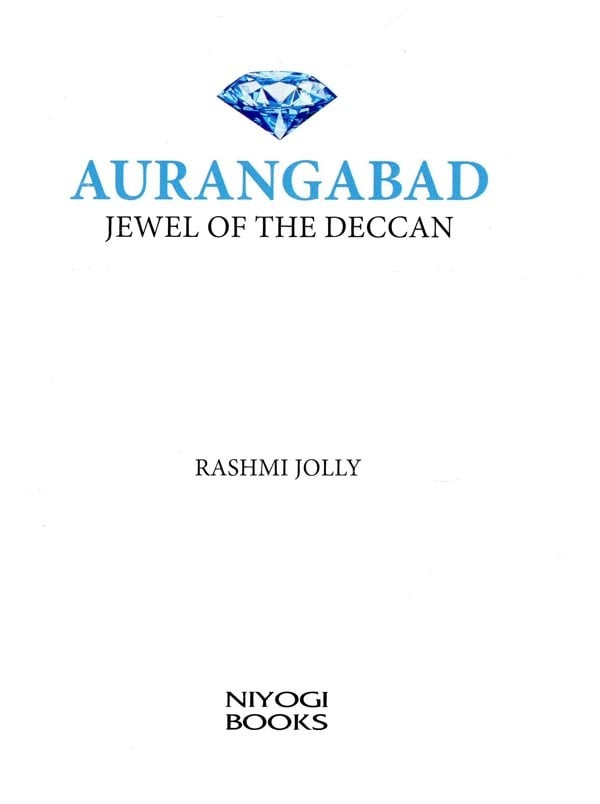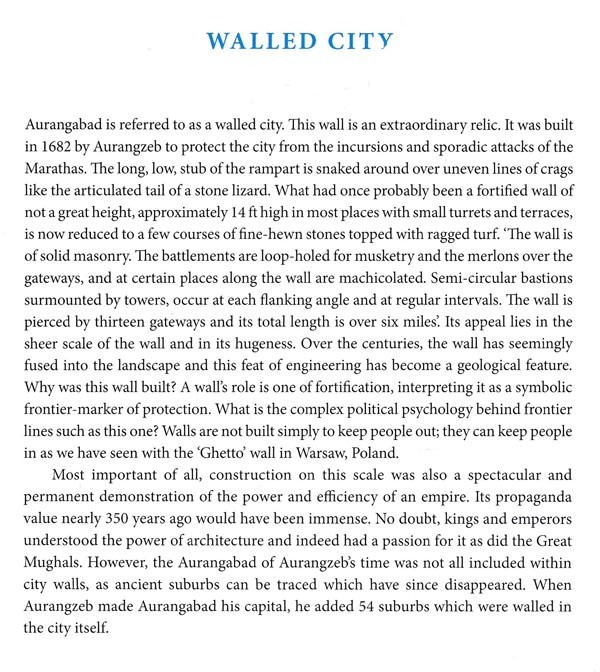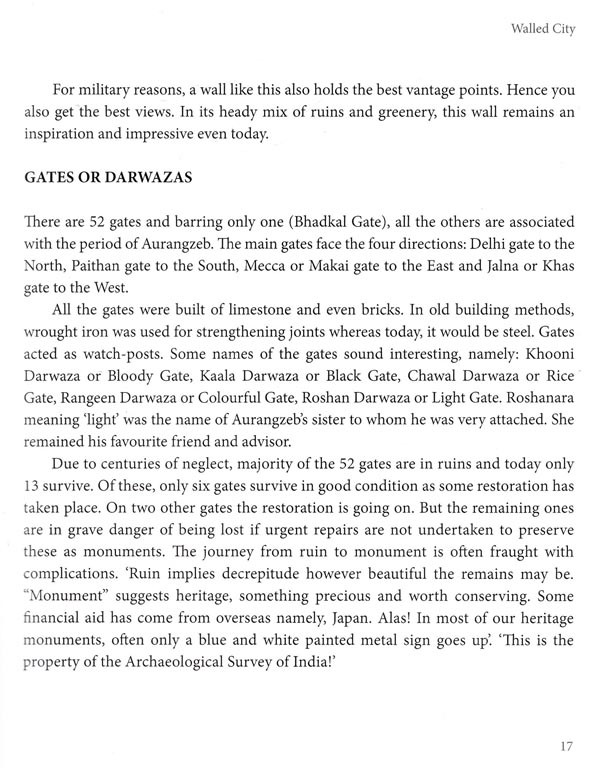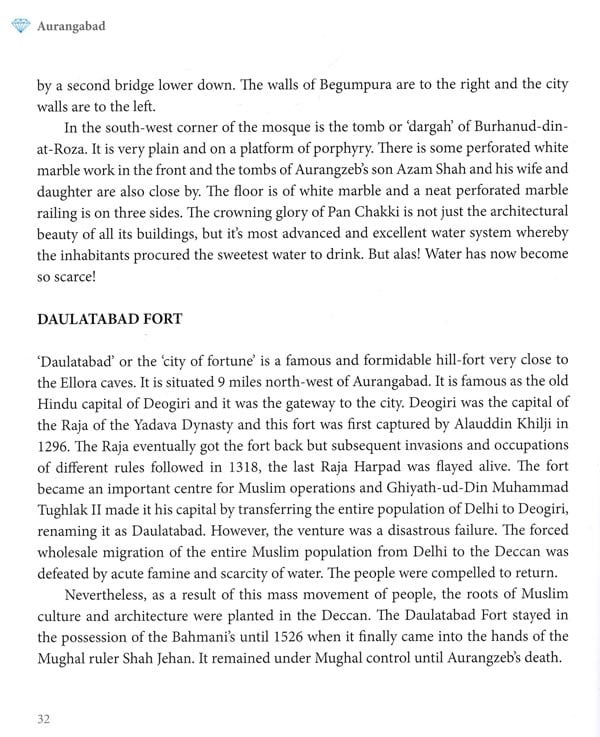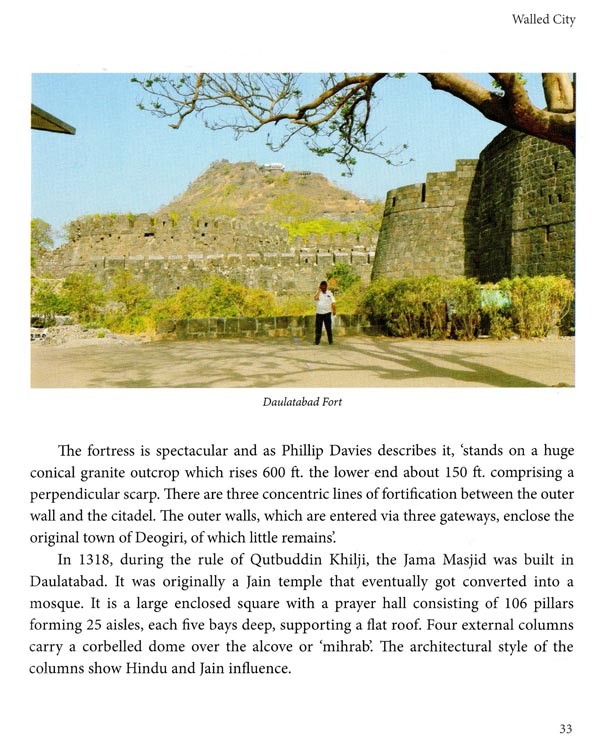
Aurangabad- Jewel of the Deccan
Book Specification
| Item Code: | AZE068 |
| Author: | Rashmi Jolly |
| Publisher: | Niyogi Books |
| Language: | ENGLISH |
| Edition: | 2022 |
| ISBN: | 9789391125592 |
| Pages: | 128 (Throughout Color Illustrations) |
| Cover: | PAPERBACK |
| Weight | 260 gm |
Book Description
Aurangabad: Jewel of the Deccan is a simple guide book that recounts for the lay tourist, briefly and accurately, the architectural and cultural splendour and history of the 'Walled City-Aurangabad. Malik Ambar, known as the founder of the city of Aurangabad, was a great supporter and patron of the arts and architecture. There is information on the fifty-two gates leading to the walled city. Some of these gates barely exist and others are in a state of repair by the Archaeological Survey of India with generous corporate patronage.
This slim volume presents in chronological order the UNESCO World Heritage sites of Ajanta, Ellora and nine Aurangabad Caves. The nine ancient caves in the city centre reveal rock-cut architecture of the highest possible standard and quality, depicting Buddhist 'Jataka' tales and other stories based on India's diverse religions. Bibi-Ka-Maqbara portrays Islamic architecture. The population of Aurangabad consists of Hindus and Muslims living in peace and harmony from time immemorial.
Mrs Rashmi Jolly has over forty years of experience as an Executive Director overseeing the public relations and export activities of the Jolly Group of Companies, Mumbai. She is now Vice-Chairperson and Executive Director of Jollyboard Ltd. An Honorary Consul of the Czech Republic for Mumbai, Maharashtra and Goa, she has been promoting Czech art, culture, fashion and music for the past ten years. An English literature graduate from Lady Shriram College, University of Delhi, Jolly has done her Post Graduate Diploma in Asian Art from the British Museum, London. As an avid collector of contemporary Indian art for over forty years, she has been published several times in the Times of India and other leading publications. A keen environmentalist, Mrs Jolly is also known to encourage and promote young and upcoming artists.
I have travelled regularly to Aurangabad from 1976 and have seen it grow from a sleepy little town to a big, bustling, industrial city today. I have felt very strongly that, even though the most beautiful books and pictures have been produced on the ancient art, history and culture of Aurangabad, it still remains an area less known and less travelled.
I saw, I read and I researched. My humble endeavour was to gather not just historical and cultural information which the best and brightest minds have covered extensively in the past, but also to try and write a sufficiently accurate, useful, practical and simple guide to lure travellers to what I consider the 'Jewel of the Deccan. However, at the time of going to the press, some things may have changed in Aurangabad. Good places may have become bad and bad places may have become better! Any such omission or oversight on my part may please be forgiven.
Please note that the discerning reader may come across an occasional slight difference either in the spelling of certain words or dates. These variations occur as they represent references taken from differing opinions. All are given credit in the bibliography.
As I still continue to be a person belonging to the old order, I find I am not so adept and computer savvy as I should be in keeping with the times. Everything I wrote, corrected and rewrote was painstakingly done in long hand. The task was sometimes daunting, however, I persisted and persevered.
HISTORICAL BACKGROUN
Every foreign tourist travelling to India is lured towards the 'golden triangle of Delhi, Agra and Jaipur. Many get to Goa and as far as Kerala, but how many of them know of the hidden jewel that is Aurangabad? Of the over 721 sites on the World Heritage List of 2001 compiled by UNESCO, some eighteen sites have been identified in India so far. Of these, the Ajanta and Ellora caves at Aurangabad were listed in 1983.Some 1500 years before Christ assimilated all his ideas and men, this synthetic genius of India had the capacity to amalgamate and fuse many religions. It resisted and yet, simultaneously absorbed and coalesced with foreign cultures. The history of India is not the story of how she underwent foreign invasions, but how she resisted them and eventually, somehow triumphed over them.
Successive cultural influences have fused together to form this fascinating country called India. Layers of diverse elements have produced a cohesive society with a unique social fabric. This synthesizing process flowered into a varied civilization during five millennia which saw the development of great creeds: Hinduism, Buddhism, Jainism and later, Islam, followed by Sikhism.
Historic India is not merely a country, but a culture based on a solid foundation transmuted from several beginnings which unifies the diversity that is India.
The early ancient history of Aurangabad is somewhat of a mystery, and scholars. have often remarked that during its early period, India lacked a Western sense of history as no accurate records were kept. India always had a tradition of oral narration, which. was passed down from generation to generation, either through legendary stories. ballad poetry or drama. **Contents and Sample Pages**
